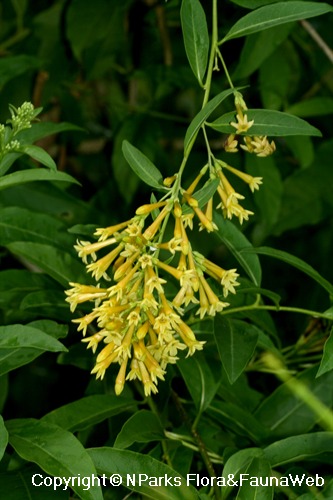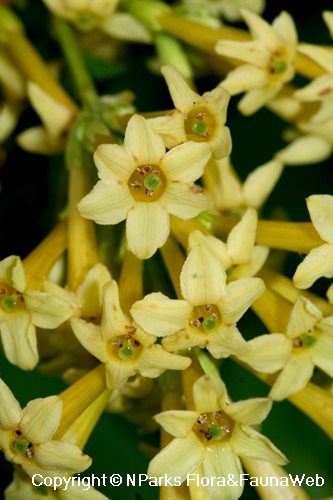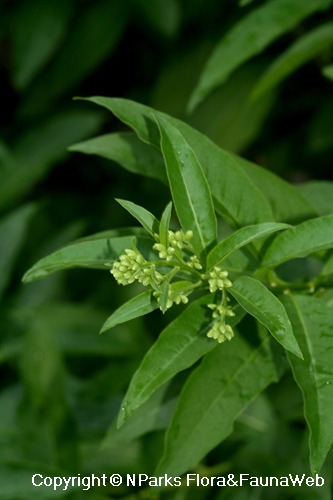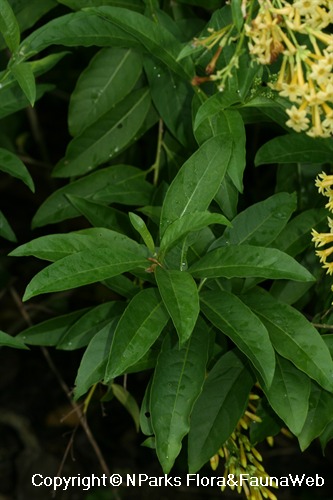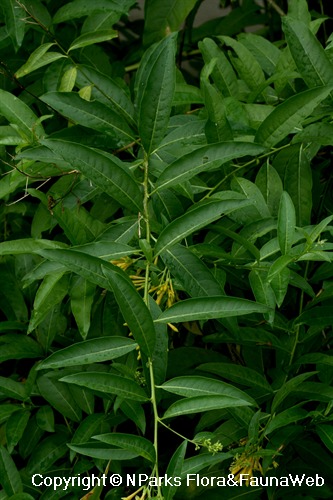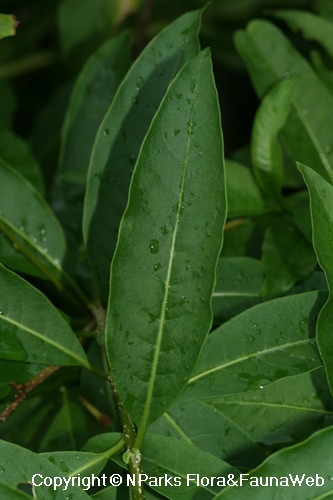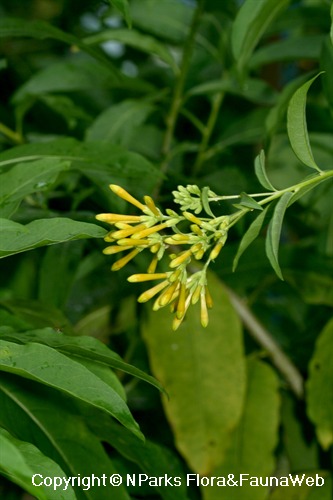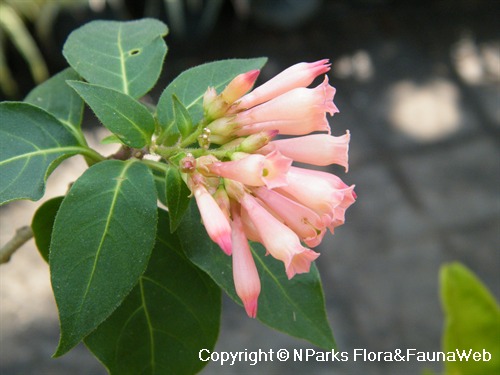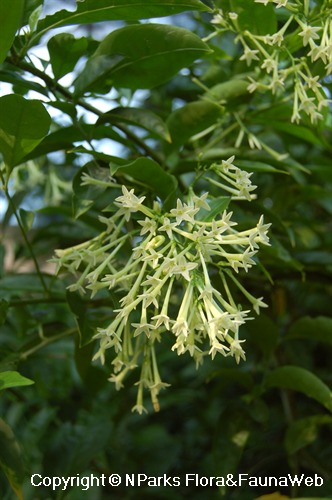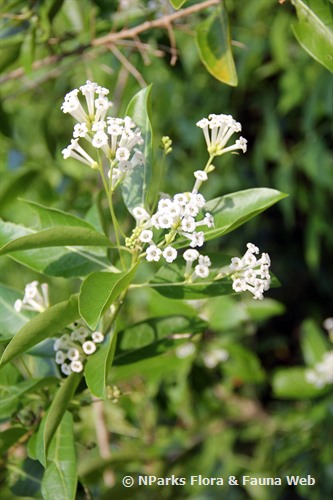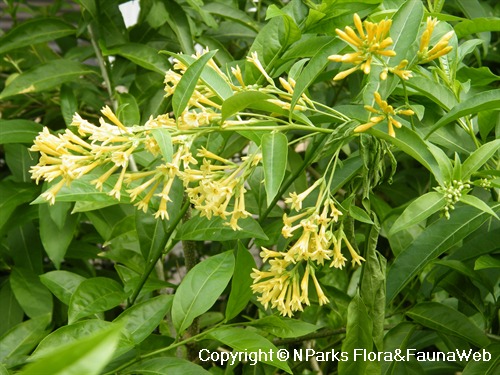
Back
Cestrum aurantiacum Lindl.
| Family Name: | Solanaceae |
| Synonyms: | Cestrum paucinervium Francey, Cestrum chaculanum Loes. |
| Common Name: | Orange Cestrum, Yellow Cestrum, Orange Jessamine, Orange Flowering Jessamine |
Name
Classifications and Characteristics
| Plant Division | Angiosperms (Flowering Seed Plants) (Dicotyledon) |
|---|---|
| Plant Growth Form | Shrub |
| Lifespan (in Singapore) | Perennial |
| Mode of Nutrition | Autotrophic |
| Maximum Height | 0.9 m to 3 m |
Biogeography
| Native Distribution | Mexico, Central America |
|---|---|
| Native Habitat | Terrestrial (Mountain) |
| Preferred Climate Zone | Sub-Tropical / Monsoonal |
| Local Conservation Status | Non-native |
Description and Ethnobotany
| Growth Form | Usually a large, evergreen flowering shrub, but it can also be a climbing vine or small tree. |
|---|---|
| Foliage | Alternate leaves are light green and ovate with entire leaf margin (13 cm long, 7 cm wide). Leaf apex is acute or has a distinct drip tip. |
| Flowers | Golden yellow flowers are tubular with 5 - 6 small, round lobes. They are arranged in clusters at branch tips (terminal clusters) and in leaf axils (axillary clusters). Flowers produce a citrus-like fragrance at night. This species blooms constantly throughout most of the year. |
| Fruit | Fruits are small, round, white berries. |
| Habitat | Occurs in mountains and disturbed areas near cities. This species is considered invasive in Swaziland (Africa). |
| Cultivation | Plant this species in fertile, well-drained soils enriched with compost. It should be located in full sun or light shade, because shady conditions inhibit flowering and result in leggy plants. Mulch the plants with compost to prevent the soil from drying out or the roots from overheating. Feed plants with a fertilizer rich in phosphorous to promote flowering. Avoid using nitrogen rich fertilizers, because they encourage development of leaves rather than flowers. Try not to prune this species frequently, because flowers are produced from the new growth. |
| Etymology | The species epithet "aurantiacum" is derived from the Latin word for orange-coloured ("aurantiacus"). Flowers of this species are sometimes orange-yellow. |
Landscaping Features
| Desirable Plant Features | Ornamental Flowers, Fragrant (Flowers) (Day, Night) |
|---|---|
| Landscape Uses | General, Flowerbed / Border, Hedge / Screening |
| Thematic Landscaping | Golden Garden, Butterfly Garden |
| Usage Hazard - Cons | Toxic Upon Ingestion |
Fauna, Pollination and Dispersal
| Pollination Method(s) | Biotic (Fauna) (Insects (Butterfly, Moth)) |
|---|
Plant Care and Propagation
| Light Preference | Full Sun, Semi-Shade |
|---|---|
| Water Preference | Moderate Water |
| Plant Growth Rate | Moderate |
| Rootzone Tolerance | Fertile Loamy Soils, Well-Drained Soils |
| Propagation Method | Stem Cutting |
Foliar
| Foliage Retention | Evergreen |
|---|---|
| Mature Foliage Colour(s) | Green |
| Mature Foliage Texture(s) | Smooth |
| Foliar Type | Simple / Unifoliate |
| Foliar Arrangement Along Stem | Alternate |
| Foliar Shape(s) | Non-Palm Foliage (Ovate) |
| Foliar Venation | Pinnate / Net |
| Foliar Margin | Entire |
| Foliar Apex - Tip | Acute, Acuminate |
| Foliar Base | Rounded / Obtuse |
| Typical Foliar Area | Mesophyll ( 45cm2 - 182.25 cm2 ) |
Non - Foliar and Storage
| Stem Type & Modification | Woody |
|---|---|
| Root Type | Underground (Tap Root) |
Floral (Angiosperm)
| Flower & Plant Sexuality | Bisexual Flowers |
| Flower Colour(s) | Yellow / Golden |
|---|---|
| Flower Symmetry | Radial |
| Individual Flower Shape | Tubular |
Fruit, Seed and Spore
| Mature Fruit Colour(s) | White |
|---|---|
| Fruit Classification | Simple Fruit |
| Fruit Type | Fleshy Fruit , Berry |
Image Repository
Others
| Master ID | 29357 |
|---|---|
| Species ID | 3666 |
| Flora Disclaimer | The information in this website has been compiled from reliable sources, such as reference works on medicinal plants. It is not a substitute for medical advice or treatment and NParks does not purport to provide any medical advice. Readers should always consult his/her physician before using or consuming a plant for medicinal purposes. |

